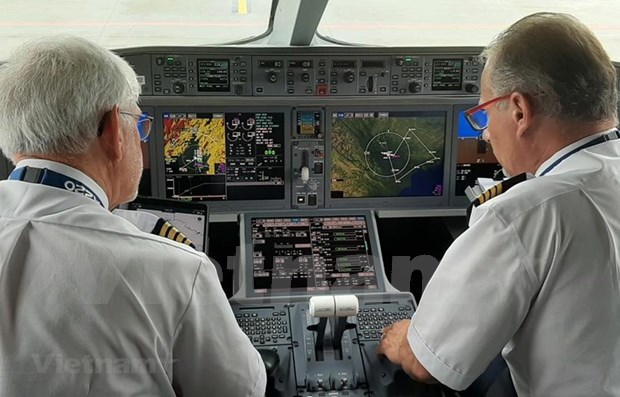Aviation sector faces shortage of pilots, safety managers
 Safety managers and pilots are in high demand in the aviation sector (Photo: VietnamPlus)
Safety managers and pilots are in high demand in the aviation sector (Photo: VietnamPlus)Hanoi (VNA) – The impressive development of Vietnam’s aviation sector is now coupled with a dire need for pilots and safety managers.
Pilots and high quality engineers are jobs with specific characteristics, while airlines are easily facing brain drain. In addition, carriers could not increase their fleets if the problem of lacking safety managers of the Civil Aviation Administration of Vietnam (CAAV) remains unsolved.
Concern over “drain” of pilots, shortage of safety managers
Statistics showed that the national flag carrier Vietnam Airlines has a fleet of 115 aircraft with total staff amounting to 20,000. Of the figure, there are 1,200 pilots, 2,500 aerospace engineers and 3,000 flight attendants.
Along with the establishment of domestic training facilities, to date, Vietnam Airlines have trained nearly 800 Vietnamese pilots out of its 1,200. As it still needs additional 400 pilots, the carrier has to recruit foreign ones.
General Director of Vietnam Airlines Duong Tri Thanh said that in initial phase, the airline had to resort to a temporary measure of hiring foreign workers in a bid to study and operate advanced machines and new aircraft, for domestic personnel failed to meet requirements of the sector.
However, foreign pilot recruitment required high cost, he added.
At the moment, Vietnamese pilots account for 75 percent in the carrier’s pilots, which proves the success of the investment and training for high quality personnel of the airline, thereby raising competitiveness and reducing cost for Vietnam Airlines.
Thanh noted a bitter truth that even though average monthly income of a Vietnamese pilot reaches at least 150 million VND (6,500 USD) and even a double amount, the carrier still faces shortage. New comers are willing to pay higher salary to attract pilots.
Meanwhile, training a pilot may take up to five years, and 8 years for Airbus 350 or Boeing 787 aircraft, added Deputy General Director of Vietnam Airlines Le Hong Ha.
Safety manager shortage is also a tough nut to crack for authorities.
A report of the Ministry of Transport showed that the number of safety managers must rise to 86 from the current 49 by 2025 to supervise 384 airplanes.
Vice head of the Civil Aviation Administration of Vietnam (CAAV) Vo Huy Cuong said that when a carrier adds 10 aircraft to its fleet, the authorities have to assign two more personnel to meet requirements of safety standards.
He added that as safety managers are civil servants, the streamlining of personnel accidentally creates more difficulties for staff recruitment. Therefore, the CAAV has to resort to hiring pilots to do the job instead.
Proper solution is needed
Vietnam Airlines continues training for its pilots and sending them abroad for further training and raise their capacity to run more complicated airplanes.
One of the secrets to success is to build a plan ensuring synchronised human resources in line with development plan, said a representative of Vietnam Airlines.
The carrier has asked ministries, departments and localities to develop high quality human resources for sustainable development.
Regarding safety managers, to ensure its operation plan in 2020, the CAAV has worked to have additional seven people to supervise 295 planes.
Vice General Director of the newest airline Bamboo Airways Nguyen Ngoc Trong said in the time to come, the carrier could send about 10 safety managers to the CAAV.
According to an aviation expert, safety managers check whether the airlines follow safety rules to operate airplanes rather than customer services. When they find out errors on flight safety and technique, they will give warnings and point out the errors in a bid to ensure safety standards./.













